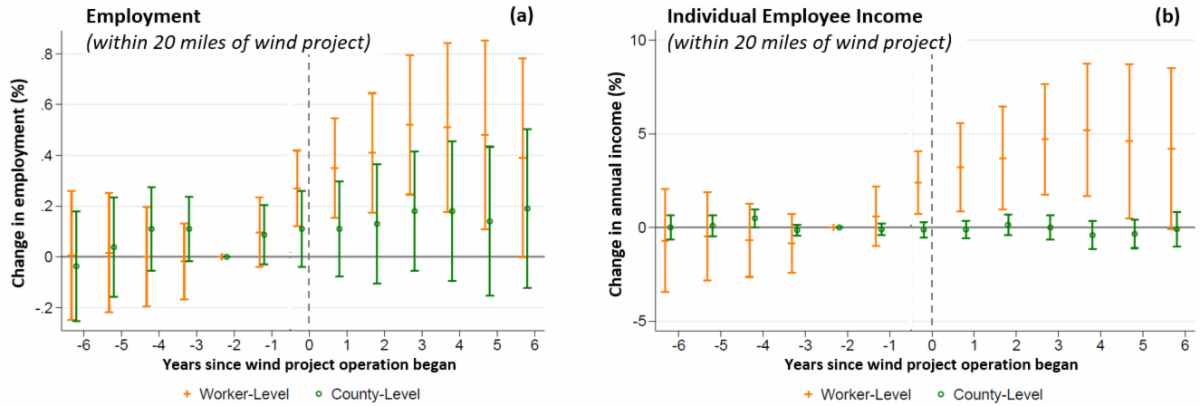Sign up for daily news updates from CleanTechnica by email. Or follow us on Google News!
The new Berkeley Lab study of more than 100 million American workers in 23 states finds clear evidence of increased employment and earnings within 20 miles of existing wind projects that begin when project construction begins and continue for many years afterward. Workers of color and those without a high school diploma enjoy large gains in both income and employment relative to other workers near wind projects.
The construction of onshore wind energy projects can be associated with several potential local economic impacts, including job creation, tax revenue, local landowner income and changes in home sale prices, for to mention a few. Because of the difficulty of collecting high-resolution data to examine relatively small effects, the economic impacts of employment and income remain understudied. This study uses data from more than 100 million individuals maintained in the US Census Bureau’s Federal Statistical Research Data Center program, 9 million of whom live within 20 miles of existing wind projects, and investigates employment and earnings data in the periods before, during and after construction of the wind project.
Lawrence Berkeley National Laboratory’s new analysis, “Employment Equity and Wage Impacts of the Energy Transition,” which was completed in collaboration with the Colorado School of Mines, compiles a unique database that includes data from employment and income from 96 percent of all workers. and all utility-scale wind projects in 23 states occurring between 2000 and 2020. All previous analyzes of wind energy impacts have relied on aggregated county-level data, which mask effects that may occur at close distances from the project. The analysis spans more than six years before any project operations begin up to six years after and focuses on effects within 20 miles of the turbines. This allows an unprecedented examination of local employment and income impacts through the full development cycle of a wind project. The study will be published in Journal of the Association of Environmental and Resource Economists in November, but is being released as a preprint version now here: https://emp.lbl.gov/
Key results include:
Effects are visible within 20 miles of an operating wind project, but not beyond that. Changes in income and employment outside 20 miles are either too small or too sporadic to detect statistically.
Within 20 miles of operating wind projects, we see employment growth of about 0.4%. This equates to approximately 230 jobs over the life of the project. This is 2 to 4 times greater than those found in previous studies. These employment increases translate into one local FTE for every $2 million invested in the wind project.
We also see clear evidence of rising incomes for workers within the 20k. An average 4% increase in income is estimated for employed workers, equal to $1,270 per year. This translates into an increase of $0.16 for every dollar invested in the wind project.

Both employment growth and income growth remain six years after wind project construction begins, implying that the effects will be felt even after construction is complete. We hypothesize that these are spillover (or secondary) effects resulting from increased tax and rent revenues collected locally and employment associated with the wind project, all of which exist over many years, if not lifetimes. complete project.
Segments of the population experience large effects compared to others. For example, black workers enjoy larger employment and income effects than white and Hispanic workers. Similarly, individuals without a high school diploma or those with a college degree see greater benefits than those who completed only high school. Finally, male workers are associated with significantly greater wind development benefits than female workers.
In all measures, the employee-level estimates used for this study are larger than the county-level estimates, which are classically based. This implies that many studies that have relied on county-level estimates may underestimate the magnitude of effects.
We thank the US Department of Energy’s Office of Wind Energy Technologies for their support of this work and the many individuals and organizations who generously provided input and reviewed our study.
Email from Ben Hoen, Lawrence Berkeley National Laboratory; Ben Gilbert, Colorado School of Mines (CSM); Hannah Gagarin, Sandia National Laboratory (formerly PhD candidate at CSM)
Berkeley Lab’s Electricity Markets and Policy Department conducts technical, economic, and policy analysis of energy topics focused on the U.S. electricity sector.
Have a tip for CleanTechnica? Want to advertise? Want to suggest a guest for our CleanTech Talk podcast? Contact us here.
CleanTechnica.TV’s latest videos

CleanTechnica uses affiliate links. View our policy here.
#largescale #wind #projects #increase #local #employment #study #effects #CleanTechnica
Image Source : cleantechnica.com